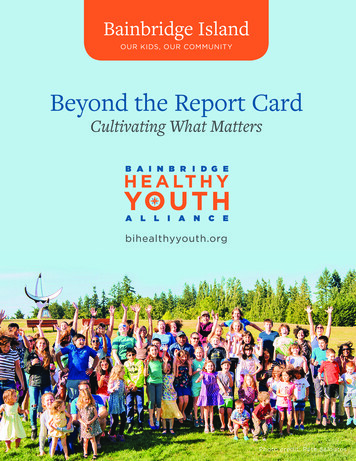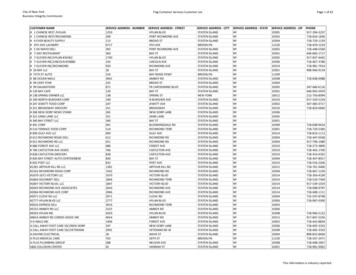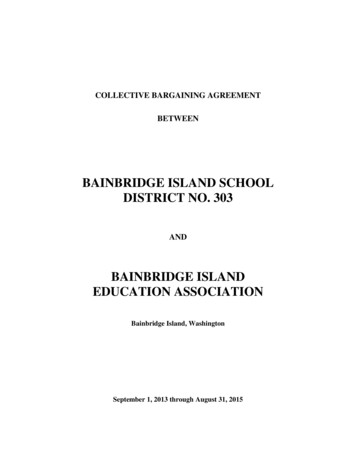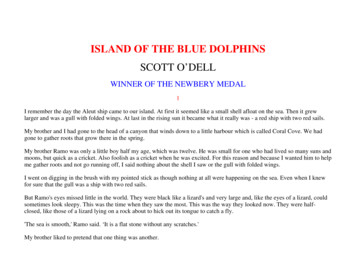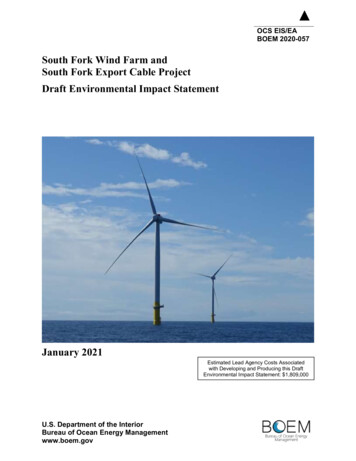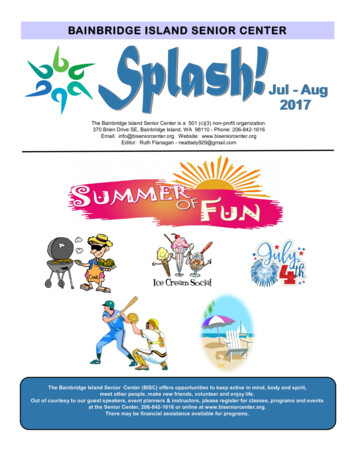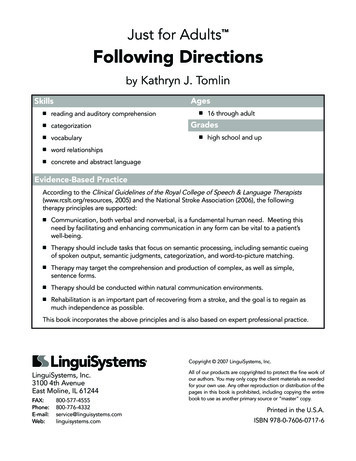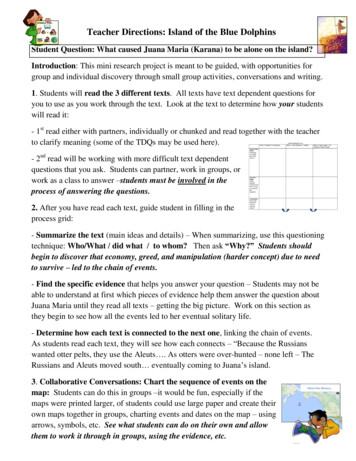
Transcription
Teacher Directions: Island of the Blue DolphinsStudent Question: What caused Juana Maria (Karana) to be alone on the island?Introduction: This mini research project is meant to be guided, with opportunities forgroup and individual discovery through small group activities, conversations and writing.1. Students will read the 3 different texts. All texts have text dependent questions foryou to use as you work through the text. Look at the text to determine how your studentswill read it:- 1st read either with partners, individually or chunked and read together with the teacherto clarify meaning (some of the TDQs may be used here).- 2nd read will be working with more difficult text dependentquestions that you ask. Students can partner, work in groups, orwork as a class to answer –students must be involved in theprocess of answering the questions.2. After you have read each text, guide student in filling in theprocess grid:- Summarize the text (main ideas and details) – When summarizing, use this questioningtechnique: Who/What / did what / to whom? Then ask “Why?” Students shouldbegin to discover that economy, greed, and manipulation (harder concept) due to needto survive – led to the chain of events.- Find the specific evidence that helps you answer your question – Students may not beable to understand at first which pieces of evidence help them answer the question aboutJuana Maria until they read all texts – getting the big picture. Work on this section asthey begin to see how all the events led to her eventual solitary life.- Determine how each text is connected to the next one, linking the chain of events.As students read each text, they will see how each connects – “Because the Russianswanted otter pelts, they use the Aleuts . As otters were over-hunted – none left – TheRussians and Aleuts moved south eventually coming to Juana’s island.3. Collaborative Conversations: Chart the sequence of events on themap: Students can do this in groups –it would be fun, especially if themaps were printed larger, of students could use large paper and create theirown maps together in groups, charting events and dates on the map – usingarrows, symbols, etc. See what students can do on their own and allowthem to work it through in groups, using the evidence, etc.
4. Create a flow map: Use the evidence to create a chain of events (flow map) to showthe causes and effects that led Juana Maria to be alone on the island. NOTE: if studentsdid this all on the map, this step is not necessary, but it might help them organize theirthoughts. This could be a great homework exercise. They can also just move directly toa flee map.5. Answer the question in an essay: Flee Map isprovided:a. Opening: Turn the question into a statement:When, who, did what, where: In 1835, a youngindigenous girl, Juana Maria, was left alone on SanNicolas Island off the coast of southern California.2nd sentence – explain what you will be writing: Here are the chain of events thatcaused her to live alone for 18 years.b. Body of Explanation: Chain of events is the “Why”- What happened first? Who/ did what? (It all began when . then have students tellabout the Russians (needing otter pelts to trade for their economy). Then add details(evidence).- What happened next? Who/ did what? (The Aleuts were used to help them hunt .then have students tell about the Aleuts (persuaded to work with the Russians to hunt forotter pelts to trade for their economy). Then add details (evidence) “What they did towhom” how the Aleuts traveled down to Southern California and why.- What happened to force Juana Maria to be alone? Who/ did what? (missing theboat, surviving and her eventual rescue).c. Conclusion: What finally happened – her death and the ironic situation about how shelived longer than her people. Students can reflect in any way they want about this – butopinion is not a part of explaining or informing.6. Reflect on the mini- research process: Talk with students in a collaborativeconversation about the process – this meta-cognitive exercise: what did we do . whatworked well what was difficult and how did you learn – will help them gain theagency needed to become more independent for the next exercise.
Student PlannerDiscovering Answers through ResearchIsland of the Blue DolphinsYour Question: What caused Juana Maria (Karana) to be alone on the island?on the island?a. Read the 3 different texts. After you have read eachtext, fill in the process grid:be alone on the island?- summarize the text (main(Karana)ideas and todetails)- find the specific evidence that helps you answer yourquestion- determine how each text is connected to the next one,linking the chain of events.b. Chart the sequence of events on the map provided usingevidence from each text to help you.- tell the story on the mapc. Use the evidence to create a chain of events (flow map) to show the causes and effectsthat led Juana Maria to be alone on the island.d. Answer the question: ”What caused Juana Maria (Karana) to be alone on theisland?” in an essay on a separate piece of paper.
How doeseach textconnectwith evidence didfind to helpyou answerthequestion?Skills:What didyou learnfrom thisarticle?SummarizingText 1: Russian Fur-TrappersText 2: Aleut Indians of AlaskaUnderstanding the TextText 3: Juana Maria: LostWoman of San Nicolas
RussiaAleutianIslandsSan NicolasIslandSanta BarbaraMission
Text 1: OnlineEncyclopedia ExcerptRussian Fur TradeRussian fur trade was a major supplier of fur-pelts to Western Europe and parts of Asia.Fur was a major Russian export and highly profitable.Expanding the HuntOriginally, Russian fur trappers hunted and sold furs from land mammals like beavers,wolves, foxes, squirrels and hares. When they had over-hunted the land mammals,Russian fur traders began to focus on maritime fur trading as there were two mammalsespecially valuable with thick, dense fur. Russian fur traders searched for the prized seaotter (With up to a million hairs per square inch, otter fur was prized for its softness andwarmth —the warmest in the animal kingdom), and later thenorthern fur seal.The Russian Empire expanded into North America,particularly Alaska to find these valuable animals. The mostprofitable furs were those of northern sea otters, whichinhabited Asia and from Alaska all the way down to thenorthern coastal waters of California. Their fur was thethickest of all, because they lived in cold waters. But they1780, drawing of sea otterdidn’t quite know how capture them in their large boats.Partnership for More OtterIn the 18th century, Russia traders establishedsettlements on the Aleutian Islands and decided topartner with the indigenous people of the PacificNorthwest coast, including the Aleut, Tlingit,Haida, and Chinook peoples of Alaska to helpthem kill sea otters. The Russians knew that thesepeople had the skills to hunt the otters in theirsmall boats, while the Russians had the big boatsto travel farther and trade the fur.Over-HuntingNow, the Russians, with thehelp of the indigenouspeople, could hunt for moreand more otter. Before the19th century there werearound 20,000 to 25,000Alaskan sea otters, but afterthe years of the Great Hunt(1790-1820), the populationin these areas was only 750.Original Otter Habitats
Expanding the HuntDuring the Great Hunt, Russian fur tradersfocused on Northern waters to find otter. Thefur of the Californian southern sea otter wasless highly prized and thus less profitablebecause the fur was not as thick as theirnorthern cousins. But after the northern seaotter was hunted to almost extinction, themaritime fur traders shifted to SouthernCalifornia shores and islands near by to huntfor sea otters. Russian fur companies took theAleuts on large ships to the targeted areas to dothe hunting in their smaller kayaks. By theearly 1800’s, the Russians and the Aleuts were hunting in the Channel Islands off thecoast of Santa Barbara.Otter pelts
Text 1: OnlineEncyclopedia ExcerptTDQs on Russian Fur Traders1. What caused Russian traders to move toward maritime fur trading?Follow up 1: What animals were valuable for maritime fur traders?Follow up 2: What clues helped us know what “maritime” means?2. What details explain why the Russian fur trappers decided to hunt for otters?3. Why do you suppose the Russians partnered with the indigenous people of Alaska?4. What do you think the “Great Hunt” was and what were the results?Follow up: How does the map help you answer the question?5. What caused the Russian fur hunters to travel south?6. Why do you think California sea otters have thinner fur than their cousins in Alaska?7. What do you think sea otter fur was used for? (use the pictures to help you infer)
Text 1: OnlineEncyclopedia ExcerptTDQs on Russian Fur Traders1. What caused Russian traders to move toward maritime fur trading? (thick, dense furof sea otters and seals)Follow up 1: What animals were valuable for maritime fur traders? (With up to amillion hairs per square inch, otter fur was prized for its softness and warmth —thewarmest in the animal kingdom)Follow up 2: What clues helped us know what “maritime” means? (opposite of landmammals, “sea otters” and “seals”)2. What details explain why the Russian fur trappers decided to hunt for otters?(opposite of land mammals, “Sea Otters” and “seals”)3. Why do you suppose the Russians partnered with the indigenous people of Alaska?(these people had the skills to hunt the otters)4. What do you think the “Great Hunt” was and what were the results?Since the population of the sea otter in these areas was only 750, then it was the 30 years(1790-1820), that the otters were hunted to near extinction.Follow up: How does the map help you answer the question?It shows where the different sea otters were and where they once existed prior to the greathunt. (“original range” may need to be explained)5. What caused the Russian fur hunters to travel south?Northern sea otters were all gone due to over-hunting.6. Why do you think California sea otters have thinner fur than their cousins in Alaska?(Warmer waters need for less dense fur)7. What do you think sea otter fur was used for? (Use the pictures to help you infer)Fur was used for hats, coats, shoes, anything to keep warm. (The text also explainsthat it was traded to Europe and Asia obviously for those reasons.) The one pictureshows Aleuts wearing coats)
Text 2: Online Encyclopedia Excerpt,maps, and Primary Source PhotographsLocationThe Aleuts Indians lived on small islands locatedoff the coast of Alaska between the Bering Sea(near Russia) and the Pacific Ocean for thousandsof years. They traded with other local islands, butbasically lived among themselves for centuries.The Aleuts Indians of AlaskaRussiaAlaskaUsing ResourcesThe Aleuts hunted seals, sea otters, whales, sealions, sometimes walrus, and, in some areas,caribou and bears. Fish, birds, and mollusks werealso taken. One-man and two-man skin boatsknown as bidarkas, or kayaks, and large, open, skinboats, Eskimo umiaks, were used. Aleut womenwove fine grass basketry; stone, bone, and ivorywere also used to create utensils.Expert Hunters WantedBy the 18th century, the Aleuts were no longersolitary people. Russian fur traders establishedsettlements on the Aleutian Islands due to thehigh demand for sea otter furs. Since the Aleutswere expert hunters of sea otter, the Russianspersuaded the Aleuts to do their hunting.Russian fur traders told the Aleuts that if theyhelped them hunt for otter, the Russians wouldtrade minerals, metal, firearms, and other goodsnot available to the Aleut. Often the RussiansRussian settlement on Aleutian Islandexploited the Aleuts, trading unsatisfactory materialsand goods, while forcing them to work long periods of time. Another problem was theRussians were depleting an important source for Aleuts, sea otter and seals. By the early1800’s there were hardly any otters left in the Northern waters surrounding the islands andshores of Alaska. Soon all were looking for sea otters farther south.
In 1811, in order to obtain more otter pelts, aparty of Aleut hunters traveled south on alarge Russian ship. They went toward theChannel Islands where sea otters wereplentiful. Before long, the Aleuts andRussians fur trappers reached the coastalisland of San Nicolas, near the AltaCalifornia-Baja border.Hunting near the larger ship.Living on these islands were many Indianswho believed the sea otter were rightfullytheirs. These indigenous Nicoleño peopleopposed the hunting and over the course of ayear their otter population was decimated,adding to the Nicoleño islanders’ tenserelationship with the fur trappers.Demanding PaymentThe locally resident Nicoleño nation, made up of more than300 people, sought a payment from the Aleut hunters for thelarge number of otters being killed in their area. They werelosing their natural resources and feared for their ultimatesurvival. In 1814, conflict finally erupted when the trapperskidnapped some Nicoleño women. A violent battle arose andbecause the Nicoleño lacked firearms, the Aleut massacrednearly all the Nicoleño men, some women and children.In coming years, there were more battles as hunters not onlywere killing their otter but their seals – a resource desperatelyneeded by the Nicoleño people. By 1835 there were less than30 Nicoleño islanders left, total.Aleut used spears during battlesbut soon learned how to useRussian guns.
Text 2: OnlineEncyclopedia ExcerptTDQs on Aleuts1. Who might have an impact on the Aleut people?Scaffold: Use the map and look where the Aleutian Islands are located.Follow up 1: Who else did the Russians probably want to trade or work with besidesthe Aleut?2. Reread the 2nd paragraph and look at the photograph. Explain this statement: TheAleutians lived off the land to survive.Follow up 1: What do you think the Aleut women used to cook their food?Scaffold: Women used bones, stone and ivory to make utensils. What do you thinkutensils were?3. Explain how the Russians exploited the Aleuts. Why did they do this?Follow up: How was “depleting the sea otter” another way the Russians exploited theAleuts?4. What caused the tense relationship between the Nicoleño islanders and the Aleuts?Follow up: What do you think “decimated the otter population” means?5. Do you think the Aleuts actions were right? Why or why not?Follow up: Why might the Aleuts have acted the way they did?
Text 2: OnlineEncyclopedia ExcerptTDQs on Aleuts ANSWERS1. Who might have an impact on the Aleut people? (look at the mapand you will see Russia – also other indigenous peoples of Alaskaand islands close by.Scaffold: Use the map and look where the Aleutian Islands are located. between/ above/right and left of other land masses or islandsFollow up 1: Who else did the Russians probably want to trade or work with besidesthe Aleut? People of Alaskan, Kamchatka, Amchitka, & Shemya2. Reread the 2nd paragraph and look at the photograph. Explain this statement: TheAleutians lived off the land to survive. The photograph shows an Aleut hunting for food inthe ocean and the text says Aleuts hunted seals, sea otters, whales, sea lions, sometimes walrus,plus fish, birds, and mollusks. From the land, they hunted caribou and bears. The picture showsthe man wearing skins and his boat of skins and wood. Also the women used grass, stone, bone,and ivory (tusks) to make bowls, tools, etc.Follow up 1: What do you think the Aleut women used to cook their food? The womenused grass, stone, bone, and ivory (tusks) to make bowls, tools for cooking, etc.Scaffold: Women used bones, stone and ivory to make utensils. What do you thinkutensils were? tools for eating and cooking3. Explain how the Russians exploited the Aleuts. Why did they do this?How Promising them to trade goods, but trading unsatisfactory materials and goods, and forcingAleuts to work long periods of time.Why: Greed and need for otter fur – they knew that the Aleuts knew how to hunt for otter betterthan the Russians did and the Aleuts’ wanted metal, minerals and other foods that they didn’thave. The Russians were more worldly and having advanced technology and goods. They usedthese to entice the Aleuts.Follow up: How was “depleting the sea otter” another way the Russians exploited theAleuts? When they no longer had local resources, the Aleuts were forced to go farther distances –without a larger boat like the Russians’, they would not have been able to hunt for otter.4. What caused the tense relationship between the Nicoleño islanders and the Aleuts?Greed - depleting the Nicoleño’s natural resources without compensation, and kidnapping theirwomen.Follow up: What do you think “decimated the otter population” means? wiping out thepopulation of otter – none left.
5. Do you think the Aleuts actions were right? Why or why not? No, because it was nottheir land or animals – or yes because they were forced into the situation themselves – survivaltactics.Follow up: Why might the Aleuts have acted the way they did? Probably to survive, andbring back goods to their own people/families (who had already lost their population of otter andseals), so the Aleuts were forced to take from others. They probably also had a fear of Russianretribution.
Text 3: Online Excerpt & PrimarySource PhotographsJuana Maria, the Lone Woman of San Nicolas IslandIntroductionJuana Maria (her Indianname is unknown) was anislander on San Nicolas,off the California coast.Beginning in 1814, thepopulation of her peoplewas nearly wiped out by a group of roving Aleutian hunters from the north. The Aleutianskilled nearly every man, woman and child on the island, and by 1835 there were less than30 islanders left, total. Juana Maria was one of the survivors.Rescuing the Remaining Nicoleña PeopleWhen news of the devastation reachedthe mainland, the Santa Barbara Missiondecided to sponsor a rescue operation. In lateNovember, 1835, the schooner, Peor es Nada,commanded by Charles Hubbard, leftMonterey, California to sail to San NicolasIsland in order to remove the remaining peopleliving there. Upon arriving at the island, Hubbard's party gathered the Indians on the beachand brought them aboard. Juana Maria, however, was not among them by the time a strongstorm arose, and the Peor es Nada's crew, realizing the immediate danger of being wreckedby the surf and rocks, panicked and sailed toward the mainland, leaving her behind. Thereare several stories that she may have jumped off the boat to rescue her daughter or brother,but it is not known if it is true.Blessing in DisguiseJuana Maria ended up completely alone onthe hostile island of San Nicolas. But itturned out that not being on the rescue boatwas a blessing in disguise. The rest of herpeople who fled to the mainland (Santa
Gabriel Mission) ended up dying almost immediately. When Hubbard brought them to SanPedro Bay, many islanders chose to live at the San Gabriel Mission. The mission had a highdeath rate because the Indians had no immunity, or resistance, against the sickness ordisease within the mission.AloneCaptain Hubbard was unable to return for Juana Maria because his boatsunk during a storm. So Juana Maria not only survived alone on theisland, but thrived there for 18 years, outliving everyone else she knew.After several failed attempts to rescue her, Juana was eventually foundin 1853 wearing as one newspaper said, " the skins and feathers ofwild ducks, which she sewed together with sinews of the seal." Thenewspaper went on to add that "she cannot speak any known language,Juana, soon afterbeing rescuedis good-looking, and about middle age." She was taken to SantaBarbara Mission.Lack of ResistanceDespite her amazing ability to survive alone for almost 20years on the island, Juana Maria did not last two monthsonce she reached the mainland, living near the SantaBarbara Mission. Many people came to see who the“Lone Woman of San Nicolas Island” was and her bodywas incapable of resisting disease. Just like her people 18years before her, Juana Maria died October 19, 1853, only7 weeks after being rescued.Juana’s burial plaque at SantaBarbara MissionAfterwardScott O'Dell's award-winning children's novel Island ofthe Blue Dolphins (1960) was inspired by Juana’s story.Scott O’Dell researched her name, and determined thatmaybe her real name was “Karana” – which sounds likethe Spanish name “Juana.”
Text 3: OnlineEncyclopedia ExcerptTDQs on Juana Maria, Lone Woman1. Why were the Aleut people on Juana’s island?Scaffold: What does roving mean in this sentence:“ nearly wiped out by a group of roving Aleutian hunters from the north.”2. Why do you think Santa Barbara Mission sponsored a rescue mission?Scaffold: Where was the mission? Who lived on Missions with the Spanish? Whywould the people of the mission care about the Nicoleña people?3. Using only evidence from the text, explain why the schooner left without Maria.4. What was the “blessing in disguise” for Juana Maria?Scaffold: How do you think Juana felt being left behind? What did she not know thathappened to her people at San Gabriel Mission? What caused the death of her people?5. Why did Juana Maria thrive, even though the rest of her people had died?6. Who rescued Juana Maria?Scaffold: Using the text features (photographs, etc.) where does it tell you who rescuedher?7. How were Juana Maria’s and the Nicoleña people’s death similar?
Text 3: OnlineEncyclopedia ExcerptTDQs on Juana Maria, Lone Woman Answers1. Why were the Aleut people on Juana’s island? They were “roving” or movingplace to place to search for otter to kill.Scaffold: What does roving mean in this sentence: (moving around)“ nearly wiped out by a group of roving Aleutian hunters from the north.”2. Why do you think Santa Barbara Mission sponsored a rescue mission? Themission, when hearing it was “devastating” took responsibility for rescuing indigenouspeople as part of the mission’s responsibility.Scaffold: Where was the mission? Who lived on Missions with the Spanish? Whywould the people of the mission care about the Nicoleña people? Missions were on themainland and inhabited the Indians – who now were dependent on the mission forfood, work, etc. The mission padres probably felt responsible for all the natives of theland and wanted to rescue them from the Aleuts and Russians.3. Using only evidence from the text, explain why the schooner left without Maria. Astrong storm came in and they would not have been able to leave if not immediately.4. What was the “blessing in disguise” for Juana Maria? The rest of her people who fledto the mainland (Santa Gabriel Mission) ended up dying almost immediately from disease.Scaffold: How do you think Juana felt being left behind? What did she not know thathappened to her people at San Gabriel Mission? What caused the death of her people?We can predict that she was fearful, because of recent events and no one to help her. Littledid she know that her people died and she remained living, if even all alone. A goodcollaborative question would be – which one was worse alone and fearful or to be rescuedand die together?5. Why did Juana Maria thrive, even though the rest of her people had died?She knew how to live off the land and had survival skills. She was not near any diseases.6. Who rescued Juana Maria? Look at the plaque and it tells you “found and bought toSanta Barbara by Capt. George Nidever.Scaffold: Using the text features (photographs, etc.) where does it tell you who rescuedher?7. How were Juana Maria’s and the Nicoleña people’s death similar? Both did not haveresistance to diseases.
Island of the Blue Dolphins Your Question: a. Read the 3 different texts. After you have read each text, fill in the process grid: - (summarize the text (main ideas and details) - find the specific evidence that helps you answer your question - determine how each text is connected to th
